-
-
August 25, 2021 at 9:37 am
Rameez_ul_Haq
SubscriberI am trying to conduct an inertia relief analysis in static structural. For an example model, I changed the locations for the supports and I observed a change in the values of rotational acceleration while the translational acceleration were the same. I think because of the type of loading I was applying, this maybe resulted in the same translational acceleration values for both the cases (i.e. before and after the change in the supports). Maybe for a different loading type for both of these cases, the translational accelerations might also be different.
I want to ask that why would support location change the value of accelerations? How should I know about the best location to apply supports? How are supports used by ANSYS to calculate the resulting accelerations? Are accelerations gotten from the solver output file for the overall model?
August 25, 2021 at 12:32 pmpeteroznewman
SubscriberRead the Theory Manual of how the Inertia Relief calculation is done to answer the last question.
https://ansyshelp.ansys.com/account/secured?returnurl=/Views/Secured/corp/v212/en/ans_thry/thy_tool2.html
Here is the first sentence from that page:
An equivalent free-body analysis is performed if a static analysis (ANTYPE,STATIC) or a buckling analysis (ANTYPE,BUCKLE) is used together with aninertia relief(IRLF,1). This is a technique in which the applied forces and torques are balanced by inertial forces induced by an acceleration field.
Inertia Relief models can have no supports.
Why would support location change the value of accelerations? Because the stiffness matrix changes when the support location changes.
How should I know about the best location to apply supports? Inertia Relief is problem specific. Show the geometry and the support choices you are considering along with the applied forces and moments for anyone to answer a specific case.
August 31, 2021 at 12:06 pmRameez_ul_Haq
Subscriber,can I trust the deformation and stress results obtained from the inertia relief? Will I get the same deformation and stress results if I take the accelerations obtained from inertia relief and use it in a linear static structural analysis? Is there a way to conduct Inertia relief ON and Large deflection ON analysis together (because that would save us time instead of re-conducting the analysis with Inertia relief OFF and Large deflection ON)?
August 31, 2021 at 9:56 pmpeteroznewman
Subscribercan I trust the deformation and stress results obtained from the inertia relief?
Yes.
Will I get the same deformation and stress results if I take the accelerations obtained from inertia relief and use it in a linear static structural analysis?
You can't run a static structural analysis on a model with no supports. If your model has supports, then you don't need inertia relief.
Is there a way to conduct Inertia relief ON and Large deflection ON analysis together (because that would save us time instead of re-conducting the analysis with Inertia relief OFF and Large deflection ON)?
See this discussion: /forum/discussion/30842/how-can-i-do-non-linear-analysis-with-inertia-relief-turned-on-on-ansys
September 1, 2021 at 7:31 amRameez_ul_Haq
Subscriberthank you for your answer and I will also have a look at the discussion which you shared.
I couldn't understand what you said in your second answer. I mean when I conduct a static structural analysis by turning large deflection OFF and inertia relief ON, then I need the supports somewhere inside my model in order to avoid the stiffness matrix being singular. After conducting a large deflection OFF and inertia relief ON analysis, I can obtain the resulting accelerations from the solver output file. Now, what I was asking is that if I re-conduct the analysis by turning large deflection OFF and inertia relief OFF and inputting the accelerations obtained from the solver output file and also by using the same supports as used with the previous analysis, then would I be getting the same displacements and stress results in my model or not? I think they should exactly be the same because I don't see any difference between these two cases.
September 1, 2021 at 9:43 ampeteroznewman
SubscriberAn internal combustion engine has a piston that moves back and forth along the cylinder, a crank shaft that spins and a connecting rod (conrod) between them. If you build a rigid dynamics model of those three parts, you can solve for the forces acting on each end of the conrod at every angle of the crank for any speed (rpm) of the crank.
A classic use for inertia relief is to import from the rigid dynamics solution the force on each end of the conrod at a particular crank angle into static structural. Only the mesh of the conrod is imported into static structural, not the crank or piston. This is an example of a model with no supports. It is a mesh with only forces applied. That is what I mean. Solve that static structural model with inertia relief to look at the stress and deformation in the conrod at that particular crank angle.
If you have enough supports to avoid a singular matrix in static structural, why are you turning on inertia relief?
If you are curious, use inertia relief on a fully supported structure and let us know what you find.
September 1, 2021 at 10:57 amRameez_ul_Haq
Subscriber,I will consider the conrod example that you gave. You said, "Only the mesh of the conrod is imported into static structural, not the crank or piston. This is an example of a model withno supports. It is a mesh with only forces applied. That is what I mean. Solve that static structural model with inertia relief to look at the stress and deformation in the conrod at that particular crank angle."
I would still need to apply supports somewhere, right? Maybe on a single point, maybe more than a point, maybe an edge, or maybe even a face? Otherwise, the static structural model will do a rigid body motion. That is exactly what I am saying. Even, as you have already said, if I want to look at the stresses and deformations, I need to solve the static structural model and without applying supports anywhere, I wouldn't be able to solve it. Choosing the appropriate locations for the application of supports is still a topic which I am unsure of, like where and how many are needed.
However, I still wasn't able to get the answer for the question which I asked in my previous comment. It was not related to what you replied, I was asking something different.
September 1, 2021 at 11:10 ampeteroznewman
SubscriberI would still need to apply supports somewhere, right?
Nope. Read the theory on Inertia Relief in ANSYS Help. Rigid body motion is set to zero in the equations sent to the solver when inertia relief is on.
Maybe you will find the answer to your question by looking at the equations in the inertia relief theory part of the manual.September 1, 2021 at 11:19 amRameez_ul_Haq
Subscriber,I read your comment somewhere where you said that not having any support inside the transient analysis will be okay and not cause any solver pivot error (or in other words, rigid body motion error) since the equations involves the damping and acceleration terms within them. So not having any supports means that the stiffness matrix term will go away, while the damping and acceleration terms may remain. In the static structural analysis, I don't think it makes use of the damping and acceleration terms within it. Because if it does, then whats gonna be the difference between the transient and static structural then? Only the stiffness matrix is involved, and having a singular stiffness matrix may cause the solution to undergo a pivot error.
I will also have a detailed look at the Inertia Relief theory inside the theory manual.
September 1, 2021 at 11:29 ampeteroznewman
SubscriberHere is the discussion that shows the simplified equations for Transient Dynamics vs. Statics. /forum/discussion/30972/difference-inertia-relief-and-transient-analysis-i-need-to-solve-this
September 1, 2021 at 11:58 amRameez_ul_Haq
Subscriber,"Maybe you will find the answer to your question by looking at the equations in the inertia relief theory part of the manual." True Need to get started on this thing. Thank you sir for your precious time :)
September 1, 2021 at 5:10 pmRameez_ul_Haq
Subscriber,I found a useful discussion. Maybe you want to have a look :)
https://engineering.stackexchange.com/questions/12455/inertia-relief-and-buckling-sol105-in-nastran
September 1, 2021 at 10:43 pmpeteroznewman
SubscriberThat discussion had a link to an ANSYS blog: https://simutechgroup.com/static-analysis-with-inertia-relief-in-ansys-workbench-mechanical/
In that blog, they explain that Inertia Relief works with supports on the body to find the accelerations that zero out the reaction forces and that different supports can have different results.
September 2, 2021 at 7:33 amRameez_ul_Haq
Subscriber,meaning that supports are indeed important to have inside the static structural analysis when inertia relief is turned ON. Supports will definitely generate almost negligble force/moment reactions so the local deformations and stresses won't be affected, but are still needed somewhere. Right? I also read the theory manual section for inertia relief in ANSYS help, but unfortunately they don't mention the necessity of having support inside the model since only the classical 2nd law of motion equations are written in that section.
September 2, 2021 at 12:54 pmpeteroznewman
SubscriberYes, you need supports on the static structural analysis when inertia relief is turned ON.
I did my own study. I used three methods of supporting a structure to use with Inertia Relief: Weak Springs, Remote Displacement (Deformable) on the left, or a 3 point kinematic mount. For systems A, B, C I applied equal and opposite forces on the left and right edges for the static equilibrium cases. For systems D, E, F, I only applied a force to the left edge, which requires there to be a ridiculously high acceleration to balance that force.
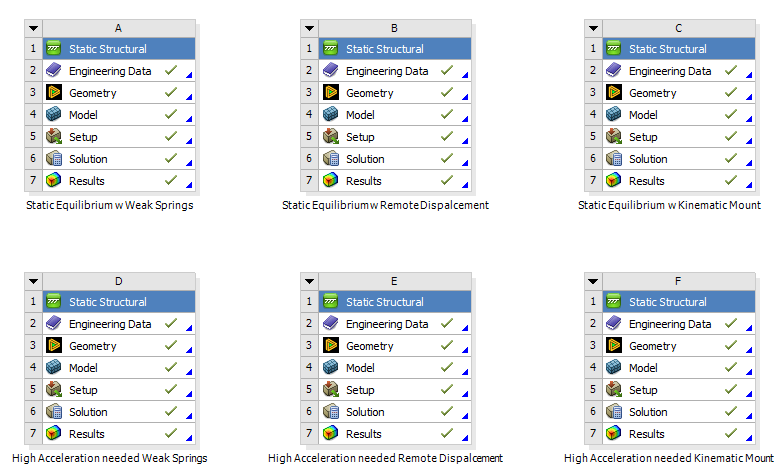
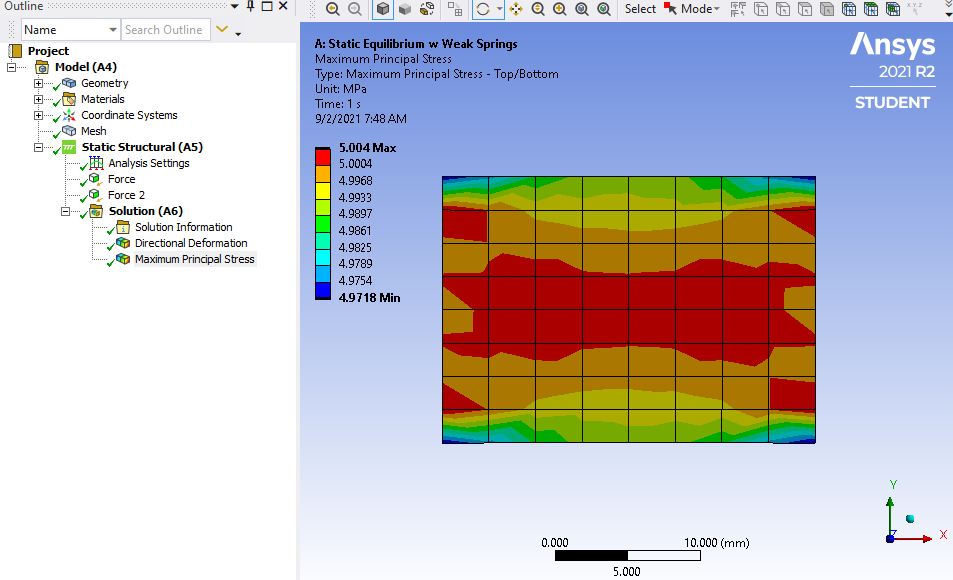
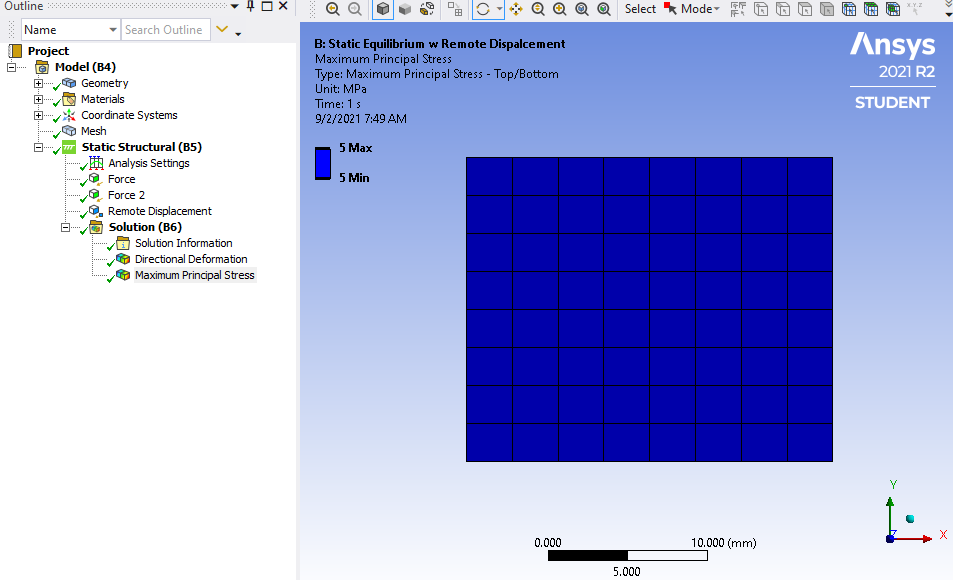
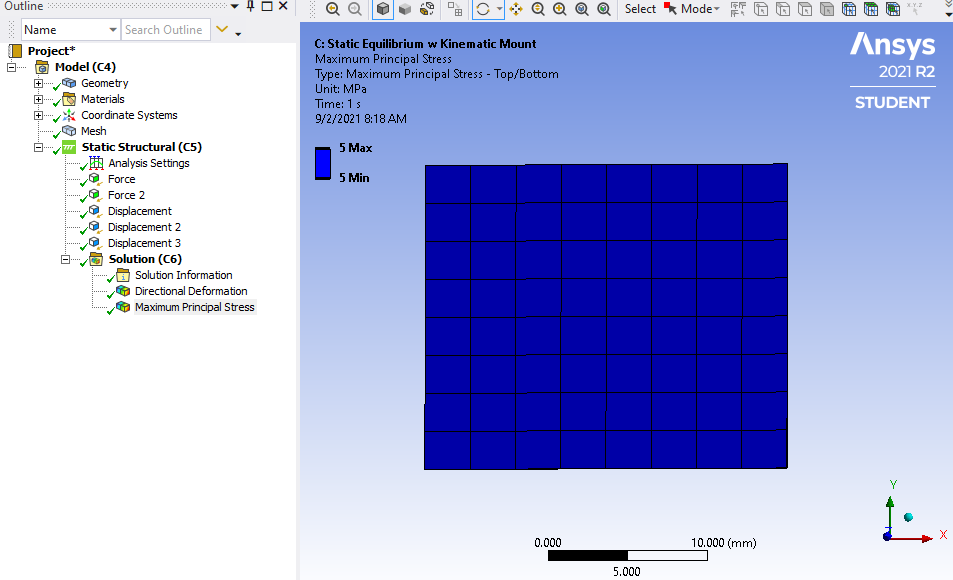 Looking at the above three results, Weak springs is slightly worse than the other two, but less than 0.5% difference from the ideal, which I would call an insignificant difference. In the results below, there is only a force on the left edge. Compared with the results above where the forces were in static equilibrium, there is a huge difference in stress when the forces are not in static equilibrium because now there is a huge acceleration field applied to the solution.
Looking at the above three results, Weak springs is slightly worse than the other two, but less than 0.5% difference from the ideal, which I would call an insignificant difference. In the results below, there is only a force on the left edge. Compared with the results above where the forces were in static equilibrium, there is a huge difference in stress when the forces are not in static equilibrium because now there is a huge acceleration field applied to the solution.
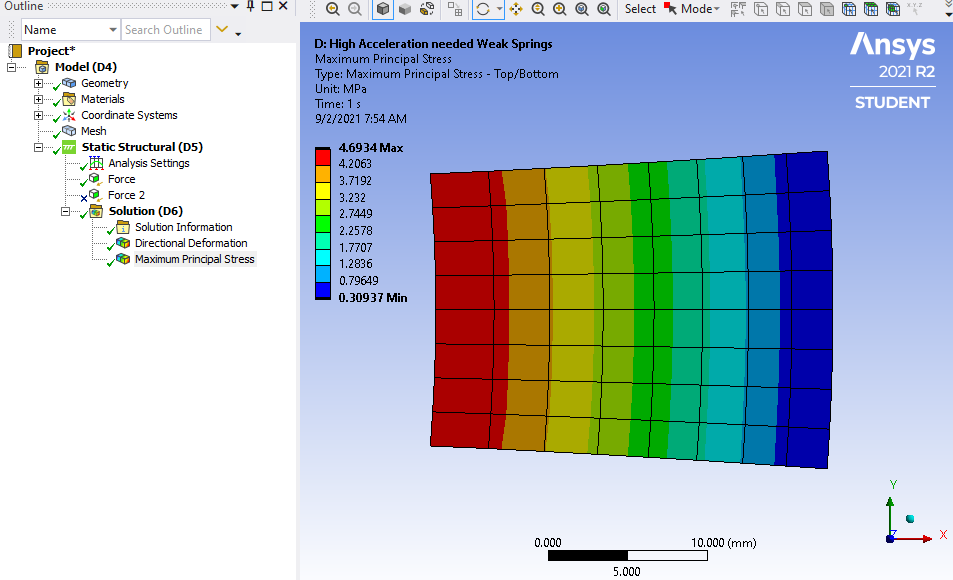
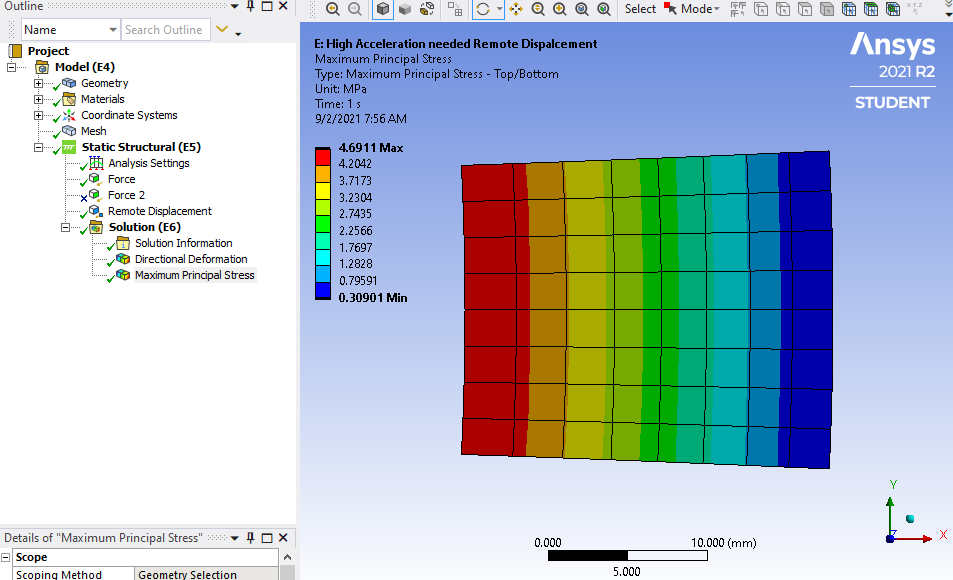
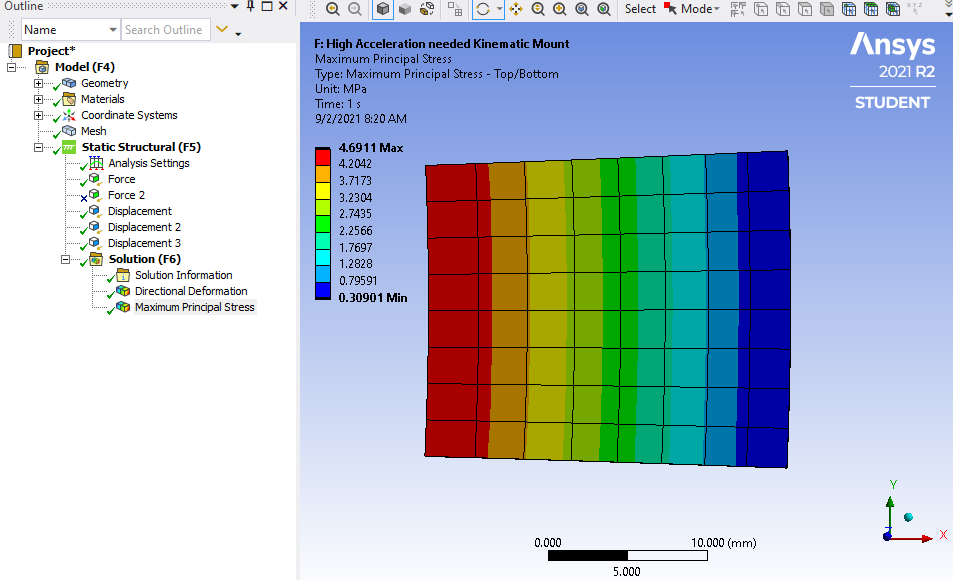 Looking at the above three results, there continues to be no difference in stress as the supports move around for the same unbalanced force on the left edge only, except Weak Springs are slightly off.
Looking at the above three results, there continues to be no difference in stress as the supports move around for the same unbalanced force on the left edge only, except Weak Springs are slightly off.
So the lesson above is that the applied forces must be correctly applied to get correct stress in an Inertia Relief model.
What happens if you turn off Inertia Relief? When the applied forces are not in static equilibrium, you get a very different stress result. The reason is there is no acceleration applied to drive the reaction forces to zero.
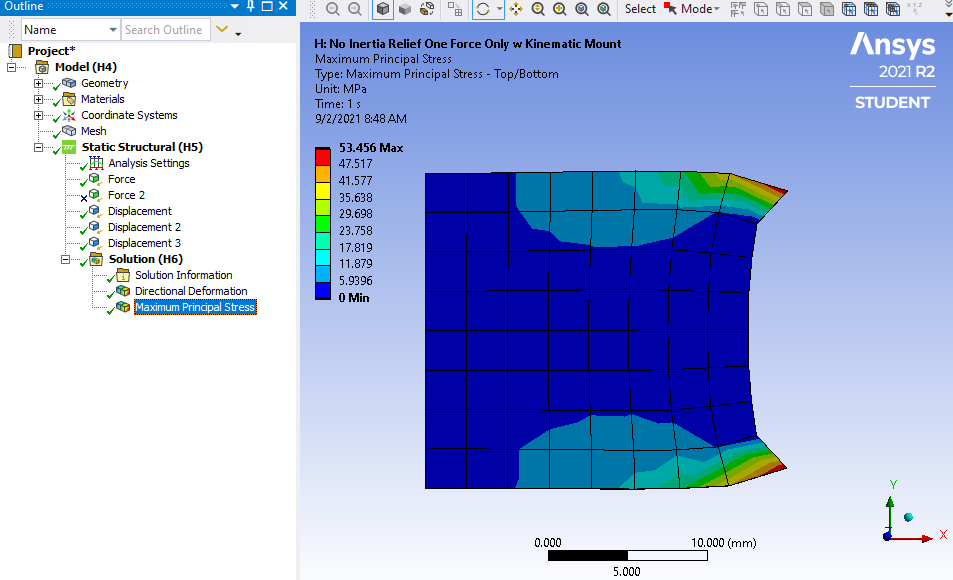 However, when the reaction forces are already zero, then there is no difference in the result.
However, when the reaction forces are already zero, then there is no difference in the result.
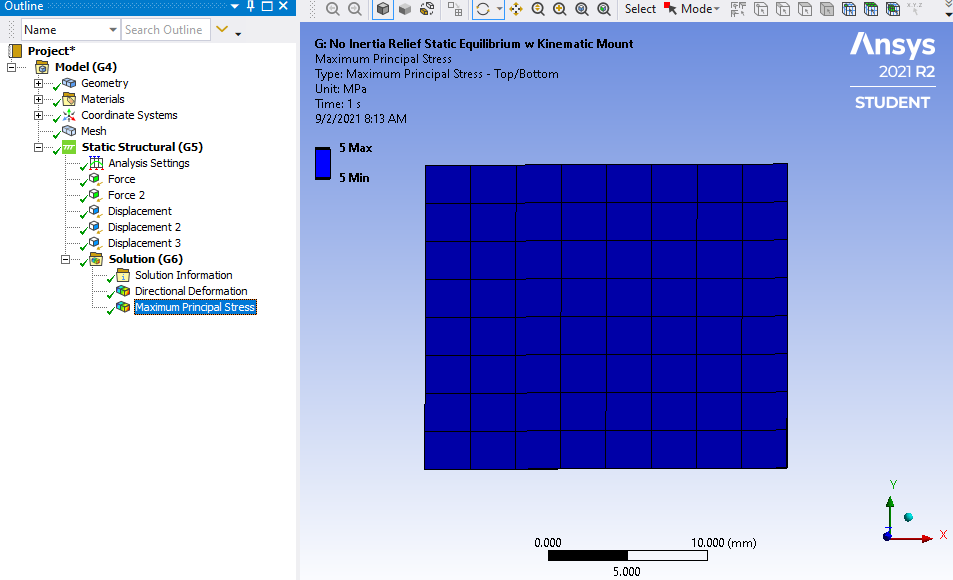 The lesson here is that when the applied forces are in static equilibrium, you get the same answer whether Inertia Relief is On or Off.
The lesson here is that when the applied forces are in static equilibrium, you get the same answer whether Inertia Relief is On or Off.
Viewing 14 reply threads- The topic ‘Is choice of supports in Inertia Relief important to consider?’ is closed to new replies.
Innovation SpaceTrending discussions- LPBF Simulation of dissimilar materials in ANSYS mechanical (Thermal Transient)
- Convergence error in modal analysis
- APDL, memory, solid
- Meaning of the error
- How to model a bimodular material in Mechanical
- Simulate a fan on the end of shaft
- Nonlinear load cases combinations
- Real Life Example of a non-symmetric eigenvalue problem
- How can the results of Pressures and Motions for all elements be obtained?
- Contact stiffness too big
Top Contributors-
4167
-
1487
-
1363
-
1194
-
1021
Top Rated Tags© 2025 Copyright ANSYS, Inc. All rights reserved.
Ansys does not support the usage of unauthorized Ansys software. Please visit www.ansys.com to obtain an official distribution.
-


Ansys Assistant

Welcome to Ansys Assistant!
An AI-based virtual assistant for active Ansys Academic Customers. Please login using your university issued email address.
Hey there, you are quite inquisitive! You have hit your hourly question limit. Please retry after '10' minutes. For questions, please reach out to ansyslearn@ansys.com.
RETRY







